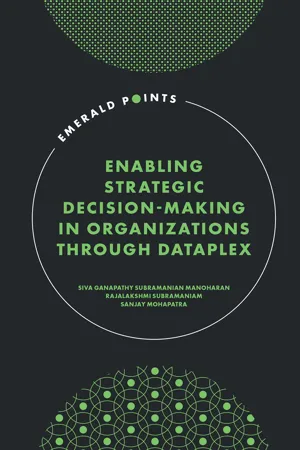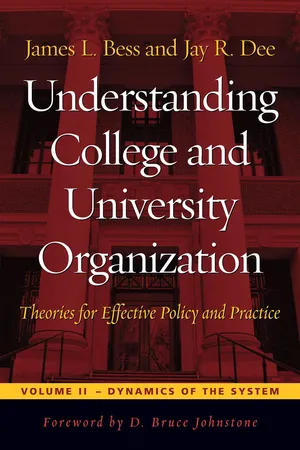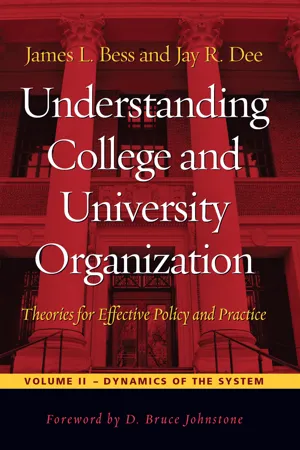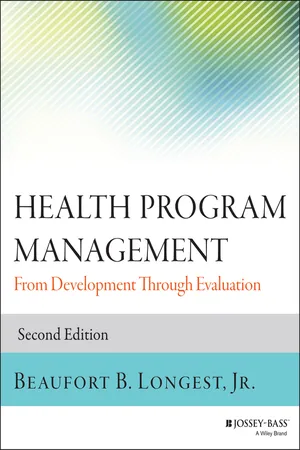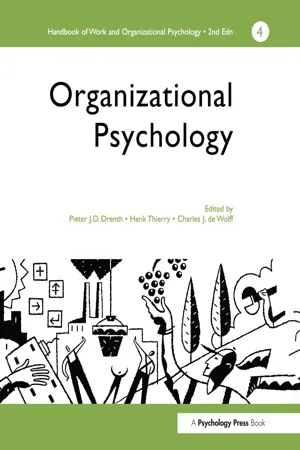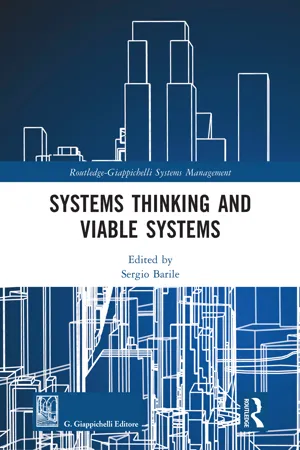Business
Organizational Decision Making
Organizational decision making refers to the process by which businesses make choices and take action. It involves gathering information, analyzing options, and selecting the best course of action to achieve the company's goals. Effective decision making is crucial for the success and growth of a business, as it impacts various aspects such as operations, finances, and overall performance.
Written by Perlego with AI-assistance
Related key terms
7 Key excerpts on "Organizational Decision Making"
- Siva Ganapathy, Subramanian Manoharan, Rajalakshmi Subramaniam, Sanjay Mohapatra(Authors)
- 2023(Publication Date)
- Emerald Publishing Limited(Publisher)
Decision-making is considered as an essential element in personal and organizational life. Numerous decisions are made by individuals in everyday life. In the business context, it is not exceptional and decision-making is required in each step. All organizational tasks, namely, planning, training, staffing, and controlling are performed through various decisions. The whole process of decision-making entails intellectual process, time, and preceding experiences. In this context, thinking process has a significant role in the whole process. Decision-making is therefore the fundamental part of different managerial activities in any organization. In the organizations, generally managers have the decision-making authority, and they have to decide what process has to be undertaken, i.e., either sensible process or intuitive process. Organizations usually make numerous decisions every single day in order to achieve their management requirements. Of these, some might be small and could be achieved quickly, whereas some are more complicated and influential and involve more detailed exploration. As decision-making happens at every nook and corner of the organization, it is therefore considered as an essential part of the manager’s role. Accomplishing the organization’s objectives in a compound and instable environment wherein concerned persons are enforced to take faster decisions and as well to transform them as fast, processes relating to decision-making are considered useful (Panpatte & Takale, 2010). The quality and promptness of decision-making is considered as the main factor of an organization’s success or failure.Making decisions is regarded as a main function of the organization. To find a solution to a problem, decision-making involves selecting a way to proceed from two or more viable options. Making a decision is a conceptual process that comprises picking one course of action from a set of alternatives. Planning is the second role of management, which will come after decision-making. Organizing, directing, coordinating, managing, and inspiring are some of the other roles that come after planning. According to Hafenbrädl, Waeger, Marewski, and Gigerenzer (2016), decisions are quickly made with the available little amount of data.According to Corso, Raimundini, Granado, and Janissek-Muniz (2014), decision-making occurs in situations of confidence and ambiguity, with the final choice producing challenges in the process.Panpatte and Takale (2019) say that the utilization of knowledge, skills, time, and prior experience is required during the decision-making process. The thought process is critical in this technique. Decisions are important because they govern organizational and managerial action. Each management level makes decisions in order to ensure that the organization’s or company’s objectives are fulfilled. Every organization must make successful decisions at some time as part of the managerial process. The organization chose to simplify the procedure. Most management choices are influenced by internal and external environmental restrictions. Management choices are made in chaotic and dangerous conditions since the environment is always changing and information is not always accurate and easily available.- eBook - ePub
Understanding College and University Organization
Theories for Effective Policy and Practice
- James L. Bess, Jay R. Dee(Authors)
- 2012(Publication Date)
- Stylus Publishing(Publisher)
Another oft-cited example is a person whose car has a flat tire but no jack to raise the car. The definition of the problem here is critical. Some would say that the problem is to locate a substitute jack to change the tire, another to find some substitute way to raise the car (or lower the ground) in order to change the tire, while still another to find an alternative means of transportation (or even to avoid the need for transportation). So also in higher education, defining the problem and establishing consensus on its definition are critical to achieving efficient and effective solutions.A brief summary of the chapter to this point is in order. Here is what we have considered about decision structures to this point: 1. All organizations have four prerequisites that describe important decisions to be made. 2. Three different kinds of decisions—strategic, tactical, and operational—are associated with each of the prerequisites at all levels of the organization. 3. Decision making in the twelve possible cells (four prerequisites by three kinds of decisions) is seldom optimal, and, because of bounded rationality, individuals usually must satisfice.The discussion thus far has been largely descriptive and classificatory. We are working our way into the question of how decisions are made in organizations. We continue with several additional contingencies that must be taken into account.Organizational Decision-Making Procedural Models
Understanding decision making is complicated by the fact that different kinds of organizations address problems quite differently and thus make strategic, tactical, and operational decisions in different ways. Hence, the very same problem in one organization may be examined and addressed quite differently in another. Different organizational designs—organic compared to mechanistic, for example—may lead to different decision-making patterns. Organizations with organic designs make decisions through informal information exchange, collaboration, and democratic decision making. Decision making in a mechanistic organization occurs through more hierarchical and bureaucratic means.This simple dichotomy, however, does not adequately describe the varieties of organizations in which decisions take place. For a more comprehensive typology, we turn to the theories of James Thompson (Thompson, 1967; Thompson & Tuden, 1959). Thompson and Tuden describe four different types of organizations. Successful organizations tend to drift toward one of these four prototypes because a particular model is found to be more effective, given the contingencies of their external environments and internal work conditions. The four prototypical organizations are created by juxtaposing two dimensions describing their cultures and belief systems: - eBook - ePub
Understanding College and University Organization
Theories for Effective Policy and Practice: Volume II — Dynamics of the System
- James L. Bess, Jay R. Dee(Authors)
- 2023(Publication Date)
- Routledge(Publisher)
Another oft-cited example is a person whose car has a flat tire but no jack to raise the car. The definition of the problem here is critical. Some would say that the problem is to locate a substitute jack to change the tire, another to find some substitute way to raise the car (or lower the ground) in order to change the tire, while still another to find an alternative means of transportation (or even to avoid the need for transportation). So also in higher education, defining the problem and establishing consensus on its definition are critical to achieving efficient and effective solutions.A brief summary of the chapter to this point is in order. Here is what we have considered about decision structures to this point:- All organizations have four prerequisites that describe important decisions to be made.
- Three different kinds of decisions—strategic, tactical, and operational—are associated with each of the prerequisites at all levels of the organization.
- Decision making in the twelve possible cells (four prerequisites by three kinds of decisions) is seldom optimal, and, because of bounded rationality, individuals usually must satisfice.
The discussion thus far has been largely descriptive and classificatory. We are working our way into the question of how decisions are made in organizations. We continue with several additional contingencies that must be taken into account.Organizational Decision-Making Procedural Models
Understanding decision making is complicated by the fact that different kinds of organizations address problems quite differently and thus make strategic, tactical, and operational decisions in different ways. Hence, the very same problem in one organization may be examined and addressed quite differently in another. Different organizational designs—organic compared to mechanistic, for example—may lead to different decision-making patterns. Organizations with organic designs make decisions through informal information exchange, collaboration, and democratic decision making. Decision making in a mechanistic organization occurs through more hierarchical and bureaucratic means.This simple dichotomy, however, does not adequately describe the varieties of organizations in which decisions take place. For a more comprehensive typology, we turn to the theories of James Thompson (Thompson, 1967 ; Thompson & Tuden, 1959 - eBook - ePub
Creative Problem Solving for Managers
Developing Skills for Decision Making and Innovation
- Tony Proctor(Author)
- 2018(Publication Date)
- Routledge(Publisher)
Chapter 14 Decision making and problem solving Introduction In an organisation, individuals, groups and teams make decisions about production, finance, human resources, marketing and many other aspects of the organisation. Decisions can range from the relatively simple and straightforward to the highly complicated involving the unknown and its attendant risks. Whatever the situation, it is usually necessary to engage in two processes – problem solving and decision making. Problem solving generates alternatives which someone having responsibility for seeking a satisfactory outcome to a problem can evaluate and choose to implement (or not). In this chapter we will first reflect on the types of decision executives may be expected to take. Next, we will review how such decisions might be taken within an organisation setting. We will consider both decisions taken by individual executives and by groups. We will observe that in practice people both as individuals and in groups take decisions using heuristics in order to simplify the complexity that surrounds decisions. We also look at a useful decision tool named the ‘analytic hierarchy process’ that can be applied to advantage where there are several alternative courses of action to consider and where there are several criteria to take into consideration. Finally, we note how creative problem-solving methods may be useful in helping along the decision-making process. Types of Decision Executives make a variety of types of decisions (see Simon, 1960). Programmed decisions are those which are normally repetitive in nature. These types of decisions are made by middle level management in accordance with some policies, rules and procedures. They have short-term impact: for example, granting leave to an employee, purchasing office materials etc. A standard procedure is followed for tackling such problems - eBook - ePub
Health Program Management
From Development Through Evaluation
- Beaufort B. Longest(Author)
- 2014(Publication Date)
- Jossey-Bass(Publisher)
In the designing activity, managers make myriad decisions as they establish the initial organization design and logic model of a program and subsequently reshape them as circumstances change. They must decide both what resources are needed and how to acquire them. They must decide what work processes will be used to achieve the desired results established through developing/strategizing. Other decisions are required when managers establish the intentional patterns of relationships among human and other resources within a program as they shape the program's organization design, the creation of which then stimulates other decisions in regard to staffing. In leading, managers must decide how to encourage other participants in a program to contribute to accomplishing the program's mission and objectives, and they must decide how to facilitate those contributions. Managers decide what means of influencing other participants will work effectively, and how they will be applied. As leaders, managers focus on the various decisions that affect the entire undertaking, including those intended to ensure the program's survival and overall well-being. Because leading effectively means motivating participants to contribute to the program's performance, managers must decide how to motivate diverse participants, each of whom has a unique set of needs that can be partially met in the workplace. Indeed, how managers conduct their decision making has a great deal to do with success in all the other activities of management work. We will begin our consideration of decision making with a definition. Decision Making Defined At its most basic level, decision making is simply making a choice between two or more alternatives (Adair 2013; McLaughlin and Olson 2012). Thinking of decision making in this way focuses attention on its essential element: making a choice. However, decision making by managers involves a process with a series of steps, which is described in detail in this chapter - eBook - ePub
A Handbook of Work and Organizational Psychology
Volume 4: Organizational Psychology
- De Charles, P J D Drenth, THIERRY HENK(Authors)
- 2013(Publication Date)
- Psychology Press(Publisher)
In the previous sections, the development of decision-making theory from a normative to an empirical phase theory was described. The position was sketched of the individual manager who, in a dynamic and sometimes chaotic environment, must arrive at decisions. While briefly discussing a few applications of the decision-making theory, we want to go into two aspects in greater detail:- recommendations with respect to decision-making in the context of organizational control;
- the influence of new technology on decision-making.
6.1 Recommendations with respect to decision-making
To guide them in their decision-making, many organizations still use old models based upon the following phases:- identification of the problem;
- definition of the problem;
- analysis of the problem;
- formulation of alternatives;
- testing the alternatives against criteria and selection;
- implementation.
However, it is known from the literature that only a few decision-making processes actually run such a course. Of the many problems that a manager observes or has pointed out to him, only the problem that exceeds a certain threshold value as to urgency is actually tackled. In fact, only very serious problems or golden opportunities are immediately taken to hand. In such cases, the decision-making process takes place very rapidly, without observance of the phases of definition, analysis, formulation of alternatives, etc. The formal sequence of phases is only followed in decisions on somewhat less pressing problems, ones that have often been around for a long time. And here the danger is most imminent that the decision-making chain is interrupted by all manner of discussions and is never completed.“Meta-decision-making” (see section 3) is therefore of great importance. Sometimes it is delegated by top management to a special functionary, the “decision controller”. He decides on the design and execution of the decision-making process; he directs the process. He is not the one to decide on the topic in question, but he determines who will be involved, when, in what phases, and in what quality in the process. It means that, for serious problems, the decision controller must make sure that the phases are taken in a somewhat orderly fashion (phenomena such as “groupthink” form the greatest threat in a chaotic process) in order to keep the decision-making at the desired level of quality. For other types of problems, he must make sure that decision-making does not come standstill at the built-in decision-making milestones or through lack of attention on the part of management. Clear and specific deadlines and the explicit assignment of decisions to people and/or bodies can stop the process from foundering prematurely. Supervisory bodies such as boards of directors, the general management, and steering committees always ought to be have a part in this, or at least be highly involved in the selection of the decision controller. - eBook - ePub
- Sergio Barile(Author)
- 2024(Publication Date)
- Routledge(Publisher)
Chapter IV The conceptual difference between decision making and problem solvingSummary:4.1. Corporate governance as a typical problematic area of Decision Making. –4.2. Business management as a typical problematic area of Problem Solving.–4.3. Towards a decision-making model based on the Viable Systems Approach.Organizations aim to survive in the context in which they operate. 1 This goal can probably be defined as the fundamental impulse that unites all viable systems. It represents the initial thrust from which, based on the type of context and the intelligence of those who are in charge of deciding, strategic choices are defined and, consequently, the short- and long-term objectives. 2 A close relationship is thus highlighted between the will to survive, the ability to dynamically understand the context and the need to choose the most appropriate strategy to adopt. Management can be understood as the discipline that deals with this essential cycle. It is not relevant whether the privileged perspective is centred on the most useful characters for survival, rather than on the easiest learning paths or, again, it is oriented to theorize the winning way to make choices; in any case, it is legitimate to argue that we are dealing with managerial issues. 31 A clean break with the tradition of profit maximization is due to Drucker, who proposed to identify the fundamental goal of the company in its survival. It must be achieved through the pursuit of a series of “survival objectives” based on five “survival functions”. Although adequate profitability is part of the objectives “the concept of maximizing profit is wrong – according to Drucker – both when interpreted in the sense of short-term and long-term profit. See Ansoff H.I. (1965 ). Corporate strategy: An analytic approach to business policy for growth and expansion. McGraw-Hill Companies, New York; Drucker P.F. (1958 ). Business Objectives and Survival Needs: Notes on a Discipline of Business Enterprise. The Journal of Business, 31
Index pages curate the most relevant extracts from our library of academic textbooks. They’ve been created using an in-house natural language model (NLM), each adding context and meaning to key research topics.
